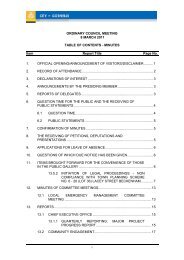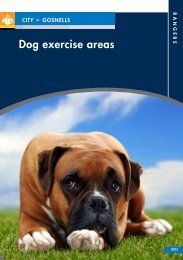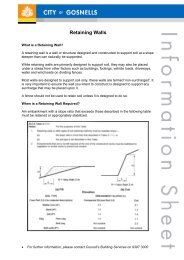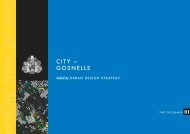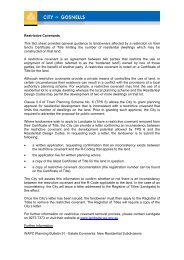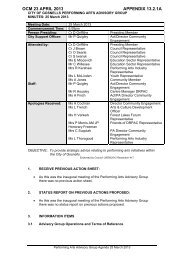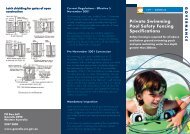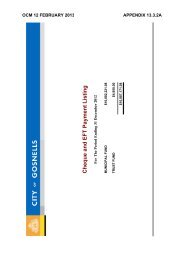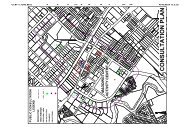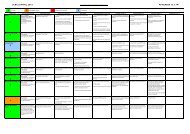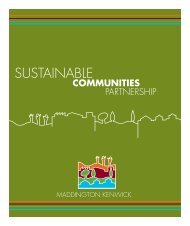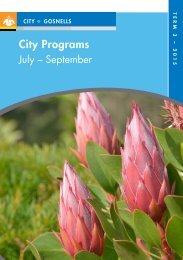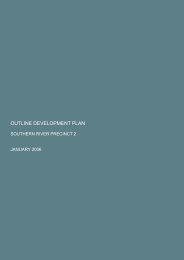Summary - City of Gosnells
Summary - City of Gosnells
Summary - City of Gosnells
Create successful ePaper yourself
Turn your PDF publications into a flip-book with our unique Google optimized e-Paper software.
Flora 411. Calytrix breviseta subsp. breviseta (Myrtaceae).This small shrub is currently listed as Endangered under the EPBC Act (DEWHA, 2008d).A small population comprising about 20 plants was found in the current survey. Calytrix brevisetasubsp. breviseta is endemic to the eastern side <strong>of</strong> the Swan Coastal Plain in the Perth MetropolitanRegion (Kelly et al., 1993), where it is only known from two populations. One <strong>of</strong> these populations iscentred on BFS 387 in Kenwick. The other population is at Bellevue. There has been a decline in thehabitat <strong>of</strong> this species at Kenwick that is probably due to falling groundwater levels and increasedsalinity resulting from local drainage practices (Luu and English, 2004). Efforts to translocate thisspecies into nearby blocks at BFS 387 have not been successful, probably due to lack <strong>of</strong> informationabout the specific habitat requirements <strong>of</strong> this shrub.2. Conospermum undulatum (Proteaceae).The current status <strong>of</strong> this species under the EPBC Act (DEWHA, 2008d) is Vulnerable. A previouslyunrecorded population <strong>of</strong> this species was found in the MKSEA during the current survey. Anotherpopulation in the MKSEA that was reported by Cardno BSD (2005) was also confirmed in this survey.This species is endemic to the foothills <strong>of</strong> the Darling Range, where it occurs in a number <strong>of</strong> smallfragmented bushland remnants from about Muchea to Maddington (Western Australian Herbarium,2009). Much <strong>of</strong> its previous habitat has been cleared.The two populations <strong>of</strong> Conospermum undulatum in the MKSEA are close to the southern range end <strong>of</strong>the species. The small sizes and fragmented distributions <strong>of</strong> Conospermum undulatum populations maybe threats to the long-term survival <strong>of</strong> the species.3. Lepidosperma rostratum (Cyperaceae).This rather inconspicuous perennial sedge is currently listed as Endangered under the EPBC Act(DEWHA, 2008d). It was found on three palusplain blocks in the current survey.Prior to the current MKSEA survey, Lepidosperma rostratum was known from one site within BFS 387and at Forrestdale Lake Nature Reserve (Western Australian Herbarium, 2009). One <strong>of</strong> the areas whereLepidosperma rostratum was found in the current MKSEA survey coincided with an occurrence <strong>of</strong>Calytrix breviseta var. breviseta. Lepidosperma rostratum has also been reported from two otherKenwick/Wattle Grove areas (Koch, 2003; Tauss, 2009).Many <strong>of</strong> the Lepidosperma rostratum plants observed in the MKSEA in early September 2007 (after thedriest year on record, 2006) appeared to be drought-stressed. Many, but not all, <strong>of</strong> these moribundLepidosperma rostratum plants recovered as the rainfall increased later in 2007. There is no data aboutthe reproductive biology <strong>of</strong> Lepidosperma rostratum. However, as this sedge lacks extensive rhizomes,it is likely to be an obligate re-seeding species. Based on the observations <strong>of</strong> this species in the MKSEAsurvey, the threatening processes that endanger Calytrix breviseta var. breviseta also appear to bethreatening Lepidosperma rostratum. Further intensive survey <strong>of</strong> this species in the area after favourablerainfall is required to establish a baseline for efforts to conserve it in the area.4.2.2 Flora <strong>of</strong> State Conservation Significance found in the MKSEAApart from the three taxa <strong>of</strong> national significance above, which are also listed as Declared Rare Flora (DRF)under the Western Australian Wildlife Conservation Act, there are nine flora taxa <strong>of</strong> State ConservationSignificance (one listed as DRF and eight as Priority Flora by the Western Australian Department <strong>of</strong>Environment and Conservation) (Atkins, 2008; Smith 2009; FloraBase, 2009) that were found in the currentfield survey <strong>of</strong> the MKSEA (Table 4.3). These taxa are described below.1. Eremophila glabra subsp. chlorella (Myoporaceae) (Declared Rare Flora).This low shrub is listed as Declared Rare Flora in Western Australia (Atkins, 2008; Western AustralianHerbarium, 2009). The most recent information available about this taxon indicates that it is extremelyrare (G.J. Keighery and R.J. Chinnock, pers. comms.).Tauss, C. and Weston, A.S. (2010). The flora, vegetation and wetlands <strong>of</strong> the Maddington-Kenwick Strategic Employment Area.A survey <strong>of</strong> the rural lands in the vicinity <strong>of</strong> the Greater Brixton Street Wetlands. Report to the <strong>City</strong> <strong>of</strong> <strong>Gosnells</strong>, W.A. Version 18.04.10



